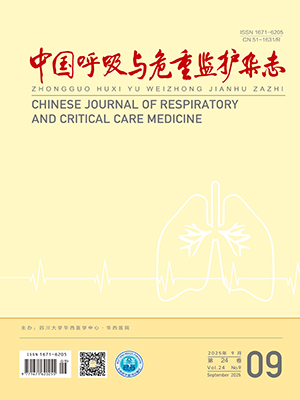Objective To evaluate the efficiency and associated factors of noninvasive positive pressure ventilation( NPPV) in the treatment of acute lung injury( ALI) and acute respiratory distress syndrome( ARDS) .
Methods Twenty-eight patients who fulfilled the criteria for ALI/ARDS were enrolled in the study. The patients were randomized to receive either noninvasive positive pressure ventilation( NPPV group) or oxygen therapy through a Venturi mask( control group) . All patients were closely observed and evaluated during observation period in order to determine if the patients meet the preset intubation criteria and the associated risk factors.
Results The success rate in avoiding intubation in the NPPV group was 66. 7%( 10/15) , which was significantly lower than that in the control group ( 33. 3% vs. 86. 4% , P = 0. 009) . However, there was no significant difference in the mortality between two groups( 7. 7% vs.27. 3% , P =0. 300) . The incidence rates of pulmonary bacteria infection and multiple organ damage were significantly lower in the NPPV success subgroup as compared with the NPPV failure group( 2 /10 vs. 4/5, P =0. 01;1 /10 vs. 3/5, P = 0. 03) . Correlation analysis showed that failure of NPPV was significantly associated with pulmonary bacterial infection and multiple organ damage( r=0. 58, P lt;0. 05; r =0. 53, P lt;0. 05) . Logistic stepwise regression analysis showed that pulmonary bacterial infection was an independent risk factor associated with failure of NPPV( r2 =0. 33, P =0. 024) . In the success subgroup, respiratory rate significantly decreased( 29 ±4 breaths /min vs. 33 ±5 breaths /min, P lt; 0. 05) and PaO2 /FiO2 significantly increased ( 191 ±63 mmHg vs. 147 ±55 mmHg, P lt;0. 05) at the time of 24 hours after NPPV treatment as compared with baseline. There were no significant change after NPPV treatment in heart rate, APACHEⅡ score, pH and PaCO2 ( all P gt;0. 05) . On the other hand in the failure subgroup, after 24 hours NPPV treatment, respiratory rate significantly increased( 40 ±3 breaths /min vs. 33 ±3 breaths /min, P lt;0. 05) and PaO2 /FiO2 showed a tendency to decline( 98 ±16 mmHg vs. 123 ±34 mmHg, P gt; 0. 05) .
Conclusions In selected patients, NPPV is an effective and safe intervention for ALI/ARDS with improvement of pulmonary oxygenation and decrease of intubation rate. The results of current study support the use of NPPV in ALI/ARDS as the firstline choice of early intervention with mechanical ventilation.
Citation: ZHI Rongchang,LI Yinhuan,HUANG Chunping,LIANG Jiezhu,ZHOU Jintian,LIU Zhitao,XU Yijun,HUANG Jinlun. Noninvasive Positive Pressure Ventilation in Acute Lung Injury and Acute Respiratory Distress Syndrome:A Randomized Controlled Study. Chinese Journal of Respiratory and Critical Care Medicine, 2012, 11(6): 522-527. doi: Copy
Copyright © the editorial department of Chinese Journal of Respiratory and Critical Care Medicine of West China Medical Publisher. All rights reserved




